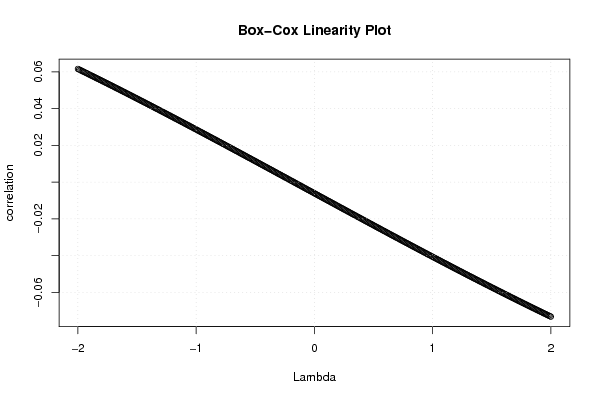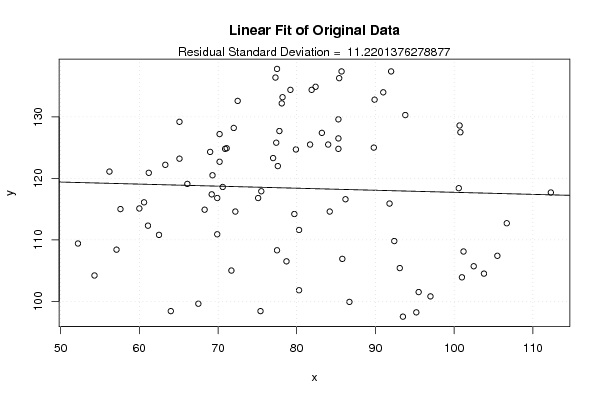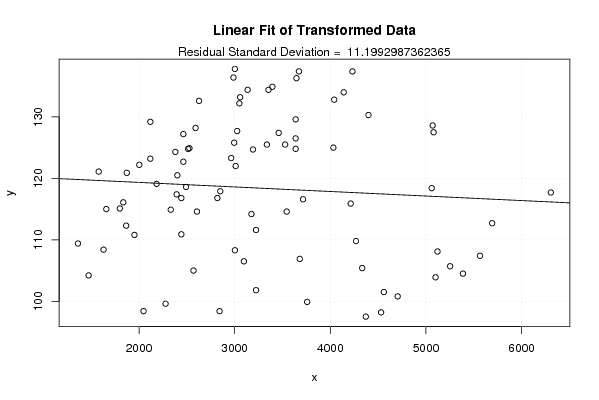Free Statistics
of Irreproducible Research!
Description of Statistical Computation | |||||||||||||||||||||||||||||||||||||||||||||
|---|---|---|---|---|---|---|---|---|---|---|---|---|---|---|---|---|---|---|---|---|---|---|---|---|---|---|---|---|---|---|---|---|---|---|---|---|---|---|---|---|---|---|---|---|---|
| Author's title | |||||||||||||||||||||||||||||||||||||||||||||
| Author | *The author of this computation has been verified* | ||||||||||||||||||||||||||||||||||||||||||||
| R Software Module | rwasp_boxcoxlin.wasp | ||||||||||||||||||||||||||||||||||||||||||||
| Title produced by software | Box-Cox Linearity Plot | ||||||||||||||||||||||||||||||||||||||||||||
| Date of computation | Wed, 12 Nov 2008 08:01:01 -0700 | ||||||||||||||||||||||||||||||||||||||||||||
| Cite this page as follows | Statistical Computations at FreeStatistics.org, Office for Research Development and Education, URL https://freestatistics.org/blog/index.php?v=date/2008/Nov/12/t1226502116y815ro0r1u6cdca.htm/, Retrieved Thu, 03 Jul 2025 05:49:33 +0000 | ||||||||||||||||||||||||||||||||||||||||||||
| Statistical Computations at FreeStatistics.org, Office for Research Development and Education, URL https://freestatistics.org/blog/index.php?pk=24231, Retrieved Thu, 03 Jul 2025 05:49:33 +0000 | |||||||||||||||||||||||||||||||||||||||||||||
| QR Codes: | |||||||||||||||||||||||||||||||||||||||||||||
|
| |||||||||||||||||||||||||||||||||||||||||||||
| Original text written by user: | |||||||||||||||||||||||||||||||||||||||||||||
| IsPrivate? | No (this computation is public) | ||||||||||||||||||||||||||||||||||||||||||||
| User-defined keywords | |||||||||||||||||||||||||||||||||||||||||||||
| Estimated Impact | 234 | ||||||||||||||||||||||||||||||||||||||||||||
Tree of Dependent Computations | |||||||||||||||||||||||||||||||||||||||||||||
| Family? (F = Feedback message, R = changed R code, M = changed R Module, P = changed Parameters, D = changed Data) | |||||||||||||||||||||||||||||||||||||||||||||
| F [Box-Cox Linearity Plot] [Various EDA topic...] [2008-11-09 16:56:36] [3548296885df7a66ea8efc200c4aca50] F PD [Box-Cox Linearity Plot] [Various EDA topic...] [2008-11-12 15:01:01] [ff1f39dba9ec26bf89aa666d9dcb6cc1] [Current] | |||||||||||||||||||||||||||||||||||||||||||||
| Feedback Forum | |||||||||||||||||||||||||||||||||||||||||||||
Post a new message | |||||||||||||||||||||||||||||||||||||||||||||
Dataset | |||||||||||||||||||||||||||||||||||||||||||||
| Dataseries X: | |||||||||||||||||||||||||||||||||||||||||||||
75,4 105,5 112,3 102,5 93,5 86,7 95,2 103,8 97,0 95,5 101,0 67,5 64,0 106,7 100,6 101,2 93,1 84,2 85,8 91,8 92,4 80,3 79,7 62,5 57,1 100,8 100,7 86,2 83,2 71,7 77,5 89,8 80,3 78,7 93,8 57,6 60,6 91,0 85,3 77,4 77,3 68,3 69,9 81,7 75,1 69,9 84,0 54,3 60,0 89,9 77,0 85,3 77,6 69,2 75,5 85,7 72,2 79,9 85,3 52,2 61,2 82,4 85,4 78,2 70,2 70,2 69,3 77,5 66,1 69,0 79,2 56,2 63,3 77,8 92,0 78,1 65,1 71,1 70,9 72,0 81,9 70,6 72,5 65,1 61,1 | |||||||||||||||||||||||||||||||||||||||||||||
| Dataseries Y: | |||||||||||||||||||||||||||||||||||||||||||||
98,4 107,4 117,7 105,7 97,5 99,9 98,2 104,5 100,8 101,5 103,9 99,6 98,4 112,7 118,4 108,1 105,4 114,6 106,9 115,9 109,8 101,8 114,2 110,8 108,4 127,5 128,6 116,6 127,4 105,0 108,3 125,0 111,6 106,5 130,3 115,0 116,1 134,0 126,5 125,8 136,4 114,9 110,9 125,5 116,8 116,8 125,5 104,2 115,1 132,8 123,3 124,8 122,0 117,4 117,9 137,4 114,6 124,7 129,6 109,4 120,9 134,9 136,3 133,2 127,2 122,7 120,5 137,8 119,1 124,3 134,4 121,1 122,2 127,7 137,4 132,2 129,2 124,9 124,8 128,2 134,4 118,6 132,6 123,2 112,3 | |||||||||||||||||||||||||||||||||||||||||||||
Tables (Output of Computation) | |||||||||||||||||||||||||||||||||||||||||||||
| |||||||||||||||||||||||||||||||||||||||||||||
Figures (Output of Computation) | |||||||||||||||||||||||||||||||||||||||||||||
Input Parameters & R Code | |||||||||||||||||||||||||||||||||||||||||||||
| Parameters (Session): | |||||||||||||||||||||||||||||||||||||||||||||
| Parameters (R input): | |||||||||||||||||||||||||||||||||||||||||||||
| R code (references can be found in the software module): | |||||||||||||||||||||||||||||||||||||||||||||
n <- length(x) | |||||||||||||||||||||||||||||||||||||||||||||

















